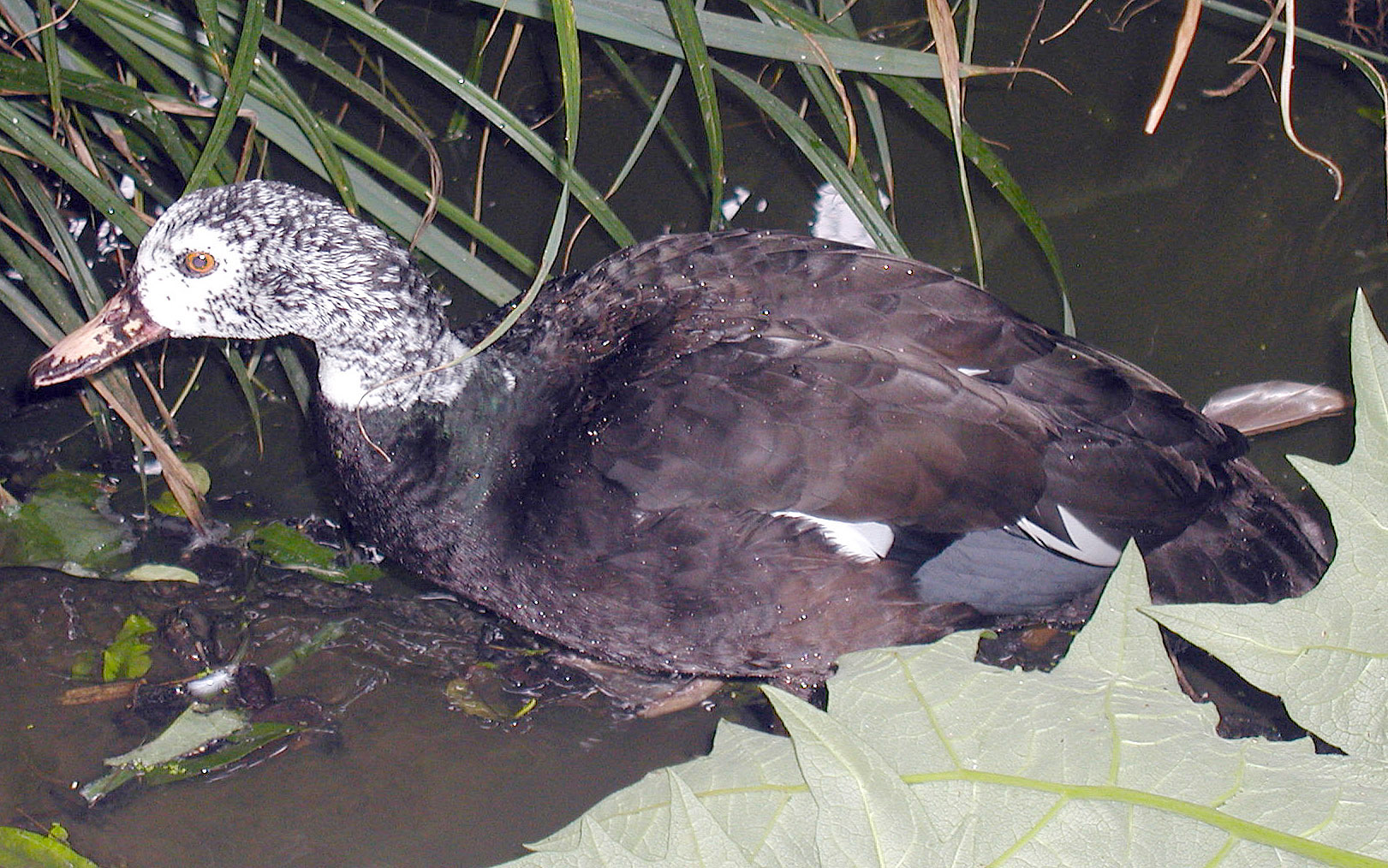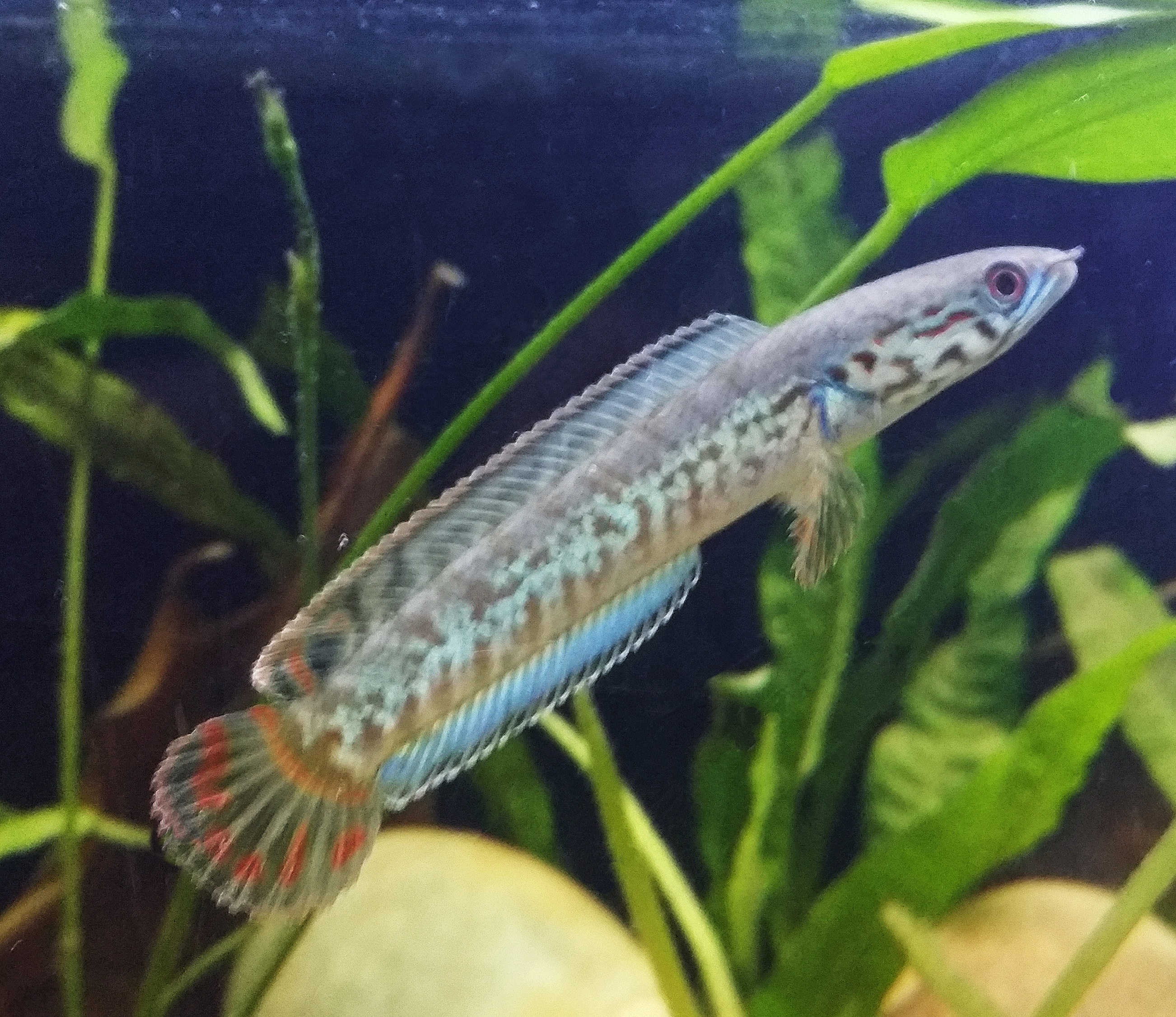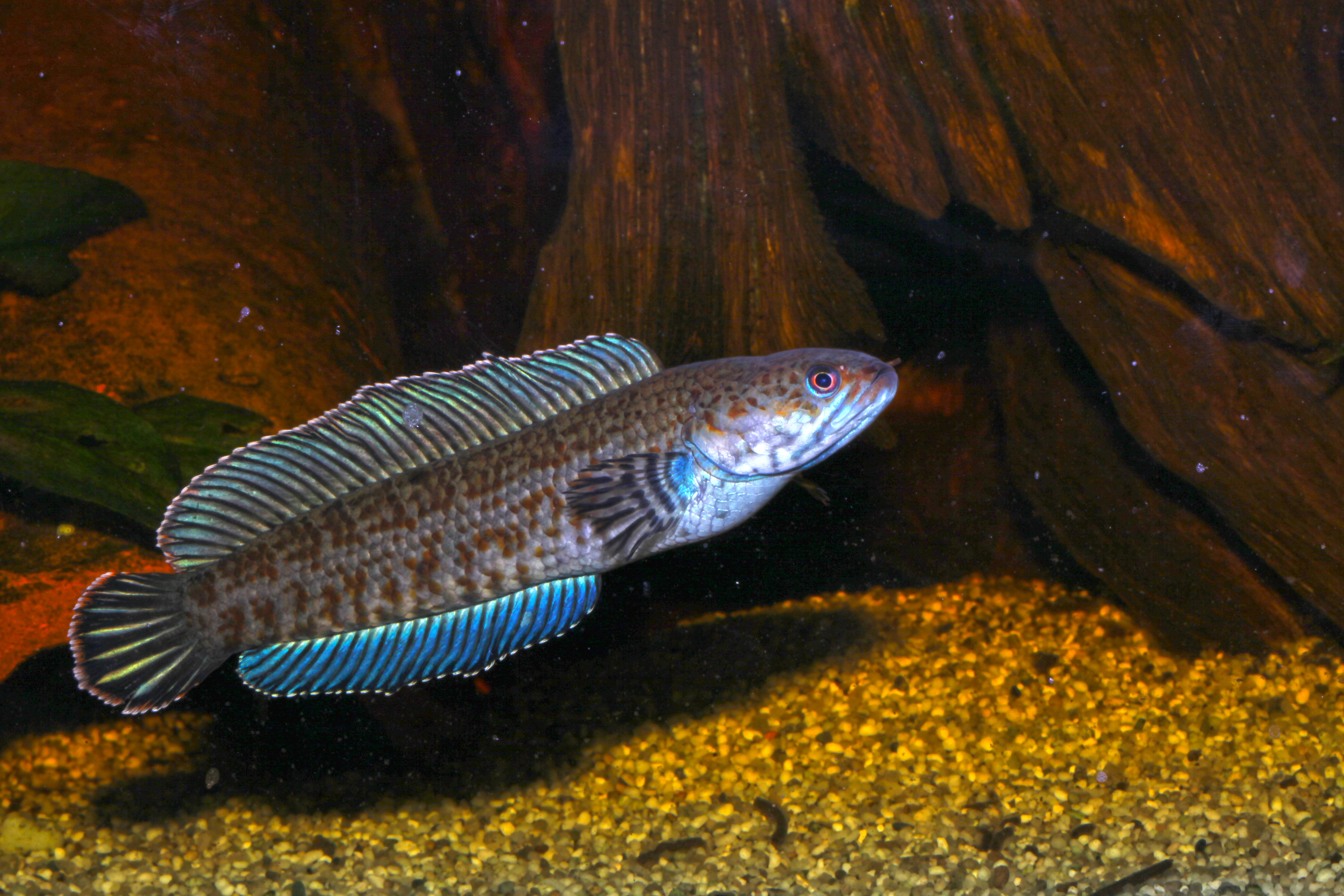|
Channa Aurantimaculata
The orange-spotted snakehead (''Channa aurantimaculata'') is a species of snakehead fish. Its body is of brownish colour intermixed with vertical orange stripes. Males have taller dorsal fins with more intense coloration, and narrower heads. It is endemic to Brahmaputra River basin. Its type locality is Dibrugarh, the most northeastern area of Assam, India. Dibrughar is the same type locality as that of '' Channa bleheri''. This species grows to 16 in (40 cm). It is probably a mouthbrooder Mouthbrooding, also known as oral incubation and buccal incubation, is the care given by some groups of animals to their offspring by holding them in the mouth of the parent for extended periods of time. Although mouthbrooding is performed by a va ..., like most of the smaller snakeheads. One report is known from a German aquarist that a couple of his fish had bred. In the aquarium The orange-spotted snakehead is predatory, so it should not be housed with smaller fishes. It is comfor ... [...More Info...] [...Related Items...] OR: [Wikipedia] [Google] [Baidu] |
Channidae
The snakeheads are members of the freshwater perciform fish family Channidae, native to parts of Africa and Asia. These elongated, predatory fish are distinguished by their long dorsal fins, large mouths, and shiny teeth. They breathe air with gills, which allows them to migrate short distances over land. They have suprabranchial organs, which are primitive forms of labyrinth organs, that develop when they grow older. The two extant genera are ''Channa'' in Asia and ''Parachanna'' in Africa, consisting of more than 50 species. They are valuable as a food source and have become notorious as an intentionally released invasive species. These fish have been kept as pets but as they get larger, people let them go into ponds, lakes, and rivers, making these fish invasive. Description The various species of snakeheads differ greatly in size; dwarf snakeheads, such as ''Channa orientalis'', do not surpass in length. Most other snakeheads reach between . Five species ('' C. argus'' ... [...More Info...] [...Related Items...] OR: [Wikipedia] [Google] [Baidu] |
Brahmaputra River
The Brahmaputra is a trans-boundary river which flows through Tibet, northeast India, and Bangladesh. It is also known as the Yarlung Tsangpo in Tibetan, the Siang/Dihang River in Arunachali, Luit in Assamese, and Jamuna River in Bangla. It is the 9th largest river in the world by discharge, and the 15th longest. With its origin in the Manasarovar Lake region, near Mount Kailash, on the northern side of the Himalayas in Burang County of Tibet where it is known as the Yarlung Tsangpo River, It flows along southern Tibet to break through the Himalayas in great gorges (including the Yarlung Tsangpo Grand Canyon) and into Arunachal Pradesh. It flows southwest through the Assam Valley as the Brahmaputra and south through Bangladesh as the Jamuna (not to be confused with the Yamuna of India). In the vast Ganges Delta, it merges with the Ganges, popularly known as the Padma in Bangladesh, and becomes the Meghna and ultimately empties into the Bay of Bengal. About long, the Bra ... [...More Info...] [...Related Items...] OR: [Wikipedia] [Google] [Baidu] |
Dibrugarh District
Dibrugarh (Pron:ˌdɪbru:ˈgor:) is an administrative district in the state of Assam in India. The district headquarters are located within the city of Dibrugarh, which the district itself is named for. The district occupies an area of 3381 km². Etymology Dibrugarh derived its name from Dibarumukh (as a renowned encampment of Ahoms during the Ahom-Chutia war). Either the name “Dibru” evolved from Dibaru river or from the Bodo-Kachari word “Dibru” which means a “blister” and “Garh” meaning "fort". The Bodo-Kacharis add the prefix “Di-” (which means “water”) wherever there is small stream, a river, or a large river in a town or city. History The region was part of the Chutia Kingdom until the Ahoms occupied it in the year 1523 AD. The Chutia army under the generals Kasitora, Alangi Chetia and Borpatra fought against the Ahoms at Dibrumukh, but were defeated. After the Ahoms captured Sadiya in 1524 AD, bringing an end to the Chutia kingdom, the Aho ... [...More Info...] [...Related Items...] OR: [Wikipedia] [Google] [Baidu] |
Assam
Assam (; ) is a state in northeastern India, south of the eastern Himalayas along the Brahmaputra and Barak River valleys. Assam covers an area of . The state is bordered by Bhutan and Arunachal Pradesh to the north; Nagaland and Manipur to the east; Meghalaya, Tripura, Mizoram and Bangladesh to the south; and West Bengal to the west via the Siliguri Corridor, a wide strip of land that connects the state to the rest of India. Assamese and Boro are the official languages of Assam, while Bengali is an additional official language in the Barak Valley. Assam is known for Assam tea and Assam silk. The state was the first site for oil drilling in Asia. Assam is home to the one-horned Indian rhinoceros, along with the wild water buffalo, pygmy hog, tiger and various species of Asiatic birds, and provides one of the last wild habitats for the Asian elephant. The Assamese economy is aided by wildlife tourism to Kaziranga National Park and Manas National Park, which are ... [...More Info...] [...Related Items...] OR: [Wikipedia] [Google] [Baidu] |
India
India, officially the Republic of India (Hindi: ), is a country in South Asia. It is the seventh-largest country by area, the second-most populous country, and the most populous democracy in the world. Bounded by the Indian Ocean on the south, the Arabian Sea on the southwest, and the Bay of Bengal on the southeast, it shares land borders with Pakistan to the west; China, Nepal, and Bhutan to the north; and Bangladesh and Myanmar to the east. In the Indian Ocean, India is in the vicinity of Sri Lanka and the Maldives; its Andaman and Nicobar Islands share a maritime border with Thailand, Myanmar, and Indonesia. Modern humans arrived on the Indian subcontinent from Africa no later than 55,000 years ago., "Y-Chromosome and Mt-DNA data support the colonization of South Asia by modern humans originating in Africa. ... Coalescence dates for most non-European populations average to between 73–55 ka.", "Modern human beings—''Homo sapiens''—originated in Africa. Then, int ... [...More Info...] [...Related Items...] OR: [Wikipedia] [Google] [Baidu] |
Channa Bleheri
''Channa bleheri'' (the rainbow snakehead) is a species of dwarf snakehead that is endemic to the Brahmaputra River basin in the Indian states of Assam and Arunachal Pradesh.SeriouslyFishChanna bleheri Retrieved 11 February 2019. It is among the most colorful species of snakehead. Distribution and etymology In the wild, this species primarily inhabits waters within the Indian state of Assam, and it is known in Assamese as ''sengeli'' or ''chengeli''. Its binomial name honors the explorer Heiko Bleher. The specific name of this fish honours the explorer and exotic fish trader Heiko Bleher who assisted in the collection of the type and gave it to Vierke. Endemic to the Brahmaputra River basin, this fish has a type location at Dibrugarh, a city in the northeastern part of Assam.Courtenay, Walter and Williams, James. ''Snakeheads (Pisces, Channidae): A Biological Synopsis and Risk Assessment''p. 63(U.S. Department of the Interior, U.S. Geological Survey, Jan 1, 2004). Its clo ... [...More Info...] [...Related Items...] OR: [Wikipedia] [Google] [Baidu] |
Mouthbrooder
Mouthbrooding, also known as oral incubation and buccal incubation, is the care given by some groups of animals to their offspring by holding them in the mouth of the parent for extended periods of time. Although mouthbrooding is performed by a variety of different animals, such as the Darwin's frog, fish are by far the most diverse mouthbrooders. Mouthbrooding has evolved independently in several different families of fish. Mouthbrooding behaviour Paternal mouthbrooders are species where the male looks after the eggs. Paternal mouthbrooders include the arowana, various mouthbrooding bettas and gouramies such as ''Betta pugnax'', and sea catfish such as ''Ariopsis felis''. Among cichlids, paternal mouthbrooding is relatively rare, but is found among some of the tilapiines, most notably the black-chin tilapia ''Sarotherodon melanotheron''. In the case of the maternal mouthbrooders, the female takes the eggs. Maternal mouthbrooders are found among both African and South American ci ... [...More Info...] [...Related Items...] OR: [Wikipedia] [Google] [Baidu] |
Channa
''Channa'' is a genus of predatory fish in the family Channidae, commonly known as snakeheads, native to freshwater habitats in Asia. This genus contains about 50 scientifically described species. The genus has a wide natural distribution extending from Iraq in the west, to Indonesia and China in the east, and parts of Siberia in the Far East. A particularly high richness of species exists in Myanmar (Burma) and northeastern India, and many ''Channa'' species live nowhere else. In contrast, a few widespread species have been introduced to several regions outside their natural range, where they often become invasive. The large and medium-sized ''Channa'' species are among the most common staple food fish in several Asian countries, and they are extensively cultured.Kumar, K., R. Kumar, S. Saurabh, M. Sahoo, A.K. Mohanty, P.L. Lalrinsanga, U.L. Mohanty and P. Jayasankar (2012). Snakehead Fishes: Fact Sheets. Central Institute of Freshwater Aquaculture, Bhubaneswar. Apart from th ... [...More Info...] [...Related Items...] OR: [Wikipedia] [Google] [Baidu] |





